
 |
||||||||||||||
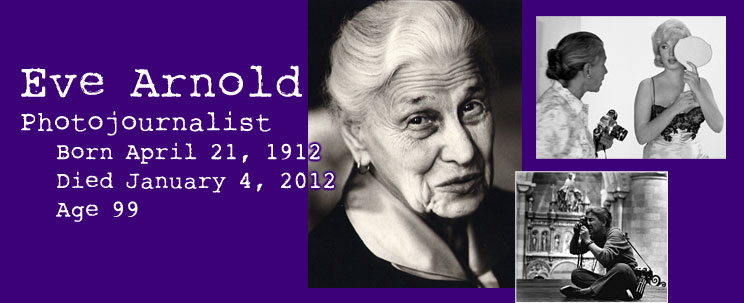 |
||||||||||||||
She took one photography class, that's all — and even as a beginner, she was singled out by the teacher, famed art director Alexi Brodovich, as having something worth pursuing. So with no formal training, she became the first American woman to be accepted by Magnum Photos, and she became a star photographer for both Life and the Sunday Times Colour Magazine. In other words, a success on both sides of the pond. And then there was Marilyn. They met when they were both starting out, the starlet and the cub photographer. This was a bond forged out of ignorance. There are millions of photos of Marilyn. Arnold said that each time she photographed Marilyn, she was different. Not just from session to session. But from frame to frame. Mood. Attitude. Shadings of mood and attitude. From personal snapshots in the toilet of the Chicago airport to interviews to formal color photos for cover stories. Arnold's secret was making sure the subject felt relaxed and safe so that an uninhibited atmosphere reveals aspects of the subject's personality that, perhaps, no one had captured before. Hollywood was a specialty. But so were psychiatric patients, horse trainers in Mongolia, factory workers in China, the nation of Islam. Wherever she pointed that camera, she did it with understanding and compassion. That was the secret. I get the first hit of the year. Eve Arnold was 99, so that's two points for the hit and five for the solo. Total: 7. — Amelia |
||||||||||||||
 |
||||||||||||||
She was one of the last links to the silent age. And she wasn't a child in the silent age. Maas was the screenwriter of 1925's The Plastic Age, which introduced Clara Bow. Introduced! It ended with what started out being a serious story and turned into a little number called The Shocking Miss Pilgrim, starring that serious actress, Betty Grable. But Maas's memoir reveals that her career writing screenplays for people like Thalberg and Louis B. Mayer was tortured, to say the least. Ideas were stolen, trod upon, altered beyond recognition. And, of course, unused. Maas and her husband, also a screenwriter, contemplated suicide but chose life instead. She became an insurance adjustor. (Hold the jokes, please.) She made a bit of a splash with a tell-all memoir in 1999, but I suspect it was a little too much, too late. Maas hated those Hollywood hacks to complete distraction, and nothing made her happier than outliving every last one of them. Frederica Sagor Maas was 111 when she died. Fireball carried Ms. Maas for a long time. He gets 1 point for the hit and 5 for the solo. Total: 6. — Amelia |
||||||||||||||
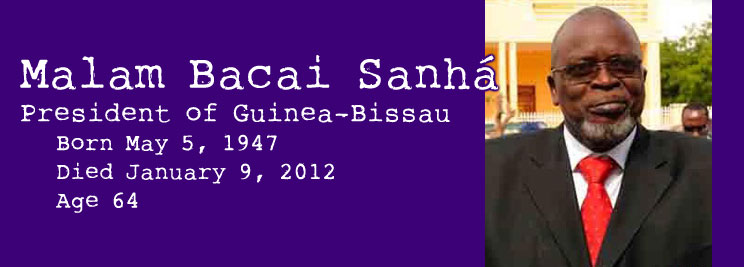 |
||||||||||||||
The big surprise about the death of the president of the tiny West African nation of Guinea-Bissau is that it was in the hospital. He did, after all, succeed an assassinated leader, which is pretty much the norm in that part of the world. A tiny nation wracked by coups, one of the main transit points for drug traffickers sending coke to Europe, this peaceful transition of power was considered a highlight in its history. Mr. Sanhá had pledged to stop the flow of cocaine-stuffed mules from South America to the archipelago of islands on the coast to the commercial flights going everywhere. Nevertheless, he appointed José Américo Bubo Na Tchuto, labeled by the U.S. Treasury Department as a drug kingpin, to head the Navy in early October. "You must prove to those who accuse you of being steeped in illicit activities that what they say does not correspond to the truth," Sanhá said at Na Tchuto's induction ceremony. Yeah, right. Mostly, Sanhá went to the hospital a lot for "routine checkups." Which is why he was on the deadpool lists of three of our crackerjack players: Another Lurker, DDT and Gerard Tierney. Malam Bacai Sanhá was 64. They get 11 for the hit and 1 for the trio. Total: 12. — Amelia |
||||||||||||||
 |
||||||||||||||
Bill Janklow, former governor of South Dakota and member of the United States House of Representatives, amassed an impressive record that few men in his position could match. Arrests for drunk driving and indecent exposure — outdoors in February in South Dakota, mind you — allegations of rape, investigations by the FBI and the Bureau of Indian Affairs, and numerous failed libel suits (attempts to cover up the rape allegations) didn't scare off voters; Janklow, a self-styled law-and-order right-wing conservative, was elected to the position of Governor five times, the last time in 1999, and rode George W. Bush's coattails into the House in 2002. That's where his good luck and pampered life of spoiled, entitled privilege ended. You see, when he was governor he could get away with all kinds of shit on a state level; he was stopped sixteen times for speeding during his last term as governor alone but was not once ticketed due to, as one officer stated, "fear of retribution." He granted all kinds of pardons when he was in office — at least to people he liked — and was so secretive about it that the Associated Press had to file Freedom of Information Act requests to get the details. Still, he was the King of South Dakota — a big fish in a very small pond — and he got his way every time. But then came August 16, 2003. Ol' Rep. Law-and-order, speeding along as usual, decided to ignore one of those pesky, unnecessary stop signs — and killed Randolph E. Scott, a 55-year-old motorcyclist. Of course, this wasn't Janklow's fault, oh no: Janklow suffered from hypoglycemia, the sad, sad, so-unfortunate result of his having given himself an insulin shot earlier that day. The jury at his trial was never told about his three previous accidents, his twelve (recorded) speeding violations, or the dozens of times he'd been stopped but let go. They still convicted him of manslaughter, and he still had to resign his seat in the House and spend 100 days in jail. One hundred days for a man's life: It's good to be the king. Bill Janklow died on January 12 at the age of 72. His driving career was full of hits, and in death he gets ten more: Allen Kirshner, Charlene, DDT, Denise, Direcorbie, Drunkasaskunk, Fireball, Gerard Tierney, Hulka and Morris the Cat each get eight points, which hopefully won't show up on their permanent records. — Charlene |
||||||||||||||
 |
||||||||||||||
Charlene, making me laugh out loud. And then making me angry. * * * Imagine you're an unemployed eight-year-old girl. No, I mean a real unemployed eight-year-old girl, since you live in Pakistan, a country where being unemployed at that age is somewhat of an accomplishment. You come from a community euphemistically described by Wikipedia as "non-elite," "pastoralist" and "traditionally involved in peasantry" — you get the idea. Your father is successful enough to give you a life of comfort, with running water, electricity, and all the modern conveniences that we in the West enjoyed in 1895, but he's a visionary: He sees even better things for you. So he scrapes enough money together to buy you a computer with Internet access so you can have e-mail, something he thinks will become very important in the modern world. What would you do? I'm guessing a lot of us would spend most of our time futzing around with whatever games we could find, with perhaps a little Wikipedia vandalism and trolling on the side. Arfa Karim decided to become a Microsoft Certified Professional, gaining accreditation at the age of nine. Yeah, nine. When most of us were faced with the epic decision of which weird kid to pick on in the playground, Arfa Karim was off getting professional accreditation and working toward her goal of studying at MIT. But success in the developing world can be cut off in the blink of an eye by factors beyond anyone's control. Health, for instance: Medical treatment you and I take for granted is just not available. Arfa Karim's ventricular septal defect — a hole between the two ventricles of the heart — was never treated and possibly never discovered until it was too late, and her epilepsy was not well managed. When a seizure caused a temporary cardiac arrest, she was basically shoved into a hospital bed and left to die. And this is where Bill Gates comes in, and I do not want to hear any Gates-slagging in this newsgroup in the foreseeable future because of this: When he learned of this development, he discussed the matter with Arfa's father, then assembled a team of eminent specialists in the United States and offered to bring Arfa over for the best possible medical treatment — all on his dime. When it became apparent that Arfa's condition was too unstable for her to be moved, he sent the specialists over to Pakistan — again, all on his dime. It wasn't enough, and Arfa, a brilliant young girl who would have become a brilliant young woman, died at sixteen because of Third World medical fuckery that even the greatest medical minds and one of the richest men in the world couldn't compensate for. Sixteen is just too damn young to die, but apparently it's not too damn young to appear on the AO Deadpool. Three players with ice in their hearts — Bill Schenley, Gerard Tierney and WEP — had Arfa Karim, and each gets 25 points for her age plus one point for the trio, and I'm guessing they'll also be getting the end-of-year bonus for the youngest hit. [That is correct. — Eds.] — Charlene |
||||||||||||||
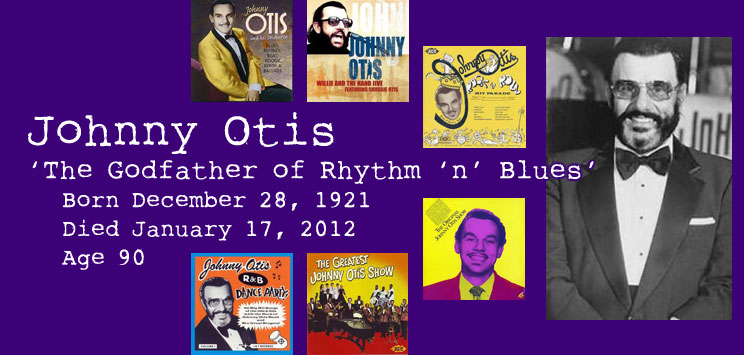 |
||||||||||||||
A lovely update from the talented Ms. Busgal. * * * So you think Alan Freed was the true father of Rock 'n' Roll? I'd give the title to another of the same age: Johnny Otis. Both were born in December of 1921. Otis, who was born and raised in the black culture of the San Francisco area, started his fame with the jazz standard "Harlem Nocturne." Blues legends who sang with his band included Wynonie Harris and Charles Brown. In 1947, he and singer/guitarist Bardu Ali opened the Barrelhouse Club in the Watts district of Los Angeles. This was a starting ground for Little Esther Phillips ("Release Me") as well as The Robins, who later became known as The Coasters. Johnny Otis is often referred to as the Godfather of Rhythm and Blues, and his first R & B material was released on Savoy in 1949. Otis produced several hits for Mercury and King, including the first hit for Etta James, "Roll With Me Henry (The Wallflower)." King was a hillbilly label at the time, but now the country guys were covering the new style, which kept a bunch of hits tied to Syd Nathan. [1] Otis also produced Big Mama Thornton's version of "Hound Dog," a homage to the other King, Elvis Presley. A deal with Capital in the late '50s gave Otis another hit with "Willie and the Hand Jive." He passed the performing genes on to his son Shuggy as Otis moved onto radio in California, as well as into the Lutheran ministry. King Daevid and I were discussing old rock legends a few years ago, and we got 3 for the hit and 2 for the duet. [1] Syd Nathan was posthumously inducted into the International Bluegrass Music Association Hall of Fame in 2006. — Busgal |
||||||||||||||
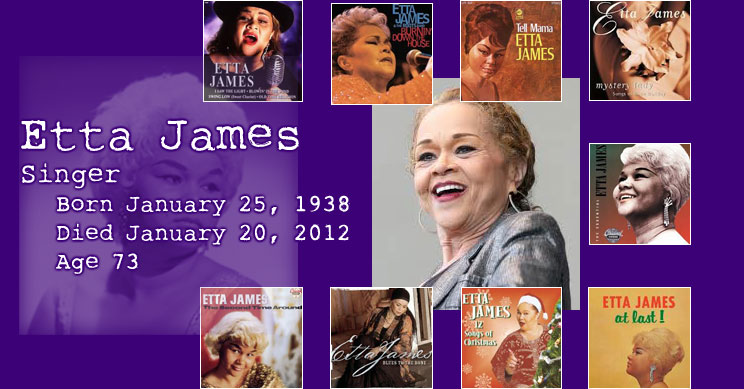 |
||||||||||||||
When music critics Thom Jurek and Robert Fontenot wrote their reviews for Beyoncé Knowles' singing performance in the movie "Cadillac Records," Jurek wrote things like "she's entirely too polished" and "her emotional conviction is lacking." Fontenot stated that Knowles "sings Etta like a diva," and that Beyoncé lacked Etta's "sly subtext and hard-won earthiness." In other words, Beyoncé knows how to sing the Blues; she just doesn't know how to have the Blues. Etta James sitting in a dressing room, half an hour before showtime, in her underwear. Bra, panties, robe over her shoulders. She pulls the robe closer, but she doesn't put her arms through the sleeves. Too confining. She is sweating profusely, and the perspiration has an overwhelming odor. It's not like sweating after a good run/workout, or even the perspiration of a hot, sunny day. It's the smell of a terrible sickness oozing out of every pore. She pulls the robe even closer as chills run up and down her spine. In front of her, on the dressing table, is a Pepsi-Cola bottle cap with a bobby-pin attached, giving it the look of a miniature saucepan. The bottle cap is charred black, and there is a wad of cotton fiber, pulled from the filter of a Kool cigarette, stuck to the inside of the cap. Etta James is in pain and all she wants is a little relief. She wants the smell to go away; she wants the chills to be someplace else. She wants the noise in her head to stop.
Soft knock on the door. Before she can look up, her quote-unquote manager drifts wordlessly across the room. He tosses her a small bundle, ten glassine envelopes, each one stamped "Tragic Magic." She empties the contents of two envelopes into her bottle cap, fills half of an insulin syringe with tap water, squirts the water into the cap, and cooks the powder to a boil. The powder was white but cooked up a dirty yellow. Using the sash from her robe, she ties off her arm and looks for a vein. When blood rushes into the syringe, she knows she is in. Etta James smiles — she has found relief ...
The first time I heard Beyoncé Knowles sing Etta James, I could hear the vacancy in her voice. She never knew about the tears. She never knew about pain, or the blues — Beyoncé never felt the joy of the Blues. But Etta James did. I always thought that Etta James was gorgeous, even when she weighed 400+ pounds. Because I never saw anything except the sound of her voice, and it was gorgeous.
Etta James, winner of six Grammys, seventeen Blues Music Awards, a member of the Rock 'n' Roll Hall of Fame, the Grammy Hall of Fame, and the Blues Hall of Fame, and still they wondered why all those rehab centers didn't work for her. She just wanted a few moments without the noise ... Was that too much for her to ask?
Forty-seven AO Deadpoolers picked Etta James to die in 2012. That is more than any pick in the entire history of the AO Deadpool: Abby, Allen Kirshner, Allezblancs, Another Lurker, Bill Schenley, Buford, Chaptal, Charlene, Chipmunk Roasting, Constant Irritant, DDT, Dead People Server, Deceased Hose, Denise, DGH, Dianagram, Direcorbie, Drunkasaskunk, EdV, Eternity Tours, Fireball, Gerard Tierney, Grim McGraw, Happy No Year, Hulka, Jason Smith, Jazz Vulture, JTH, Kathi, Keister Button, King Daevid, Loki, Mark, Mo, Moldy Oldies, Monarc, Morris the Cat, Ray Arthur, Reporter Man, Roxanne Wiggs, The Wiz, Tim J., HAWTHORN Tom, Walking Dead Dude, WEP, Where's my damn list? and Worm Farmer. And why shouldn't all these lovely people benefit? It was an easy eight points — she was in a coma and dying, without a chance of seeing Valentine's Day. Total: 8.
— Bill Schenley |
||||||||||||||
 |
||||||||||||||
Unsolicited update. I LOVE IT. From reigning champion Morris the Cat, who also got the hit. Solo. 13 points. Knows how to play deadpools. Knows how to write. What more can we ask for? * * * Now I'm no artsy type or fashionista. But when I read about the many costume-designing and art-directing accomplishments, and overall lavish praise, for Eiko Ishioka, who died from pancreatic cancer in Tokyo at age 73 on January 21, I had to do a Google Images search to see what all the fuss was about. So look what comes up under Eiko Ishioka costumes. Alrighty then. With rare exception, to me it's practically the same damned outfit for nearly every movie, Broadway play, Olympic ceremony, and Cirque du Soleil show she ever costume-designed for. Change a color or a strap or a hem line or a bustle size, maybe? So I guess it was her all-out ordinary regularity that made her win all these awards: an Oscar (for Bram Stoker's Dracula), a Cannes Film Festival jury award (for Mishima: A Life in Four Chapters), a Grammy (for the Miles Davis album Tutu), two Tony nominations (for M. Butterfly), and many others. One might ask: So where's your Emmy, Eiko? Oh, she also did the Spider-Man stage show. At the beginning, at least, maybe it was her designs that caused the actors to slip out of their costumes and take some death-defying (and injurious) falls? I'll give her this much: Eiko Ishioka, who got more than 200 obituaries written about her in publications worldwide (I did another web search), timed it right. She is probably being added right now to the all-important, much AO-discussed and debated, and vastly enjoyed Oscars "Obit Reel" for the upcoming Academy Awards, thankfully hosted by Billy Crystal instead of Eddie Murphy, Sunday night, February 26, live (although probably a slight tape delay in case someone like Meryl Streep or George Clooney swears), on ABC. Hope Ishioka is dressed nicely for the fleeting few seconds they give her somewhere alongside Elizabeth Taylor, Sidney Lumet, Peter Falk and Jane Russell. — Morris the Cat |
||||||||||||||
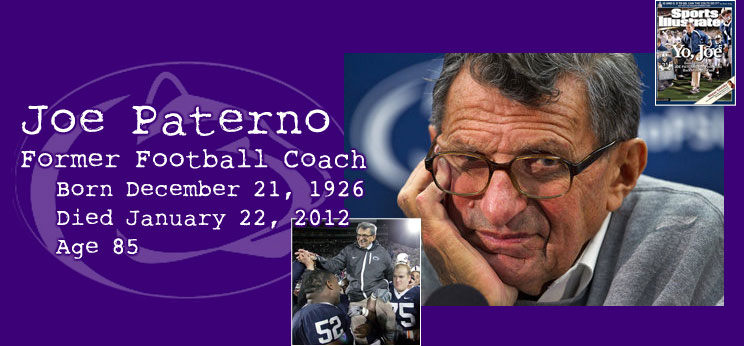 |
||||||||||||||
A wonderful tribute by a Pennsylvania boy. * * * Erik Brady, who is a sportswriter for USA Today, tells a story about interviewing Joe Paterno in the late 1980s. Brady's mother was born on campus in 1914, but her family moved away when she was two and never returned. During the interview with JoePa, Brady related this to the coach. While they were talking, Paterno was rooting through a drawer, found what he was looking for, scribbled something on a white sheet, stuffed the sheet into a manila envelope, and handed it to Brady as he was leaving, along with instructions to send the envelope on to his mother. In the envelope was a glossy photo of Joe Paterno and he signed it: "Eileen, this place hasn't been the same since you left. Best wishes, Joe Paterno." This has been the kind of story heard on the State College campus about the iconic coach, who had given more than six decades of his life to Penn State. For this one week, Joe Paterno was given a pass by the media that had descended upon Center County, PA. The other guy was not mentioned. When Joe Paterno took over for Rip Engle as the Nittany Lions' head football coach in 1966, Penn State was about as popular in Pennsylvania as Shippensburg State. Pitt was the football program of choice in the Keystone State. Almost immediately, Joe Paterno changed that. Within three years, Penn State was no longer considered "eastern football." [1] It would remain a national powerhouse for the next forty-five years. As Penn State football grew, so did Penn State. Money from Paterno's powerful football program built everything from dorms to computer labs to the girl's softball field. Joe Paterno and his wife personally donated a million dollars to the PSU library. And so, when his funeral procession snaked through the streets of the tiny Pennsylvania hamlet known as State College, thousands of people lined those streets, many openly weeping for a man who, in their eyes, could do no wrong — their coach, their teacher, their neighbor. A man who had become a father figure not only to his players, but to his university. Thousands cheered as the coach's hearse passed them by until the hearse neared Beaver Stadium. Then there was a solemn quiet. And when a voice shouted from the silence "You. Are. Penn State!", tears poured from the eyes of the adoring. Twelve hundred miles away, our house was not immune. Bill Schenley, Busgal, Denise, Dianagram, Drunkasaskunk, Jason Smith, Kathypig1, Monarc, Reporter Man, Roxanne Wiggs, The Wiz, Tim J., Walking Dead Dude and Worm Farmer all knew that if lung cancer didn't kill him, a broken heart certainly would. They each get five points for the death of Joe Paterno, who was arguably college football's greatest coach. Total: 5. [1] Eastern football was considered the Ivy League, Holy Cross, Army, Navy, Lehigh, etc. — Bill Schenley |
||||||||||||||
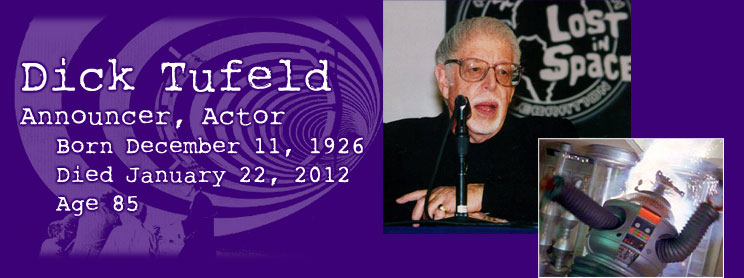 |
||||||||||||||
See how amazing it is to get other people to write these? New voices, new points of view. Fabulous. Thanks, RH Draney, you rock. * * * In a world before Don LaFontaine, TV fans seldom noticed the voices of announcers. Every once in a while, the observant would recognize an old friend like Olan Soulé, Casey Kasem or Don Pardo reading the tag at the end of more than one favorite show. But most of them were just that: voices. If they turned up at all during the program proper, it was as an announcer (!) on a little TV screen that the main characters were watching, reading a news bulletin or the like. Then there was Dick Tufeld. As announcer for The Hollywood Palace or the televised Grammy awards, he signed off so many times with "This is Dick Tufeld speaking" that some people thought his name was Dick Speaking, middle name Tufeld. Mark Evanier, who was co-producer of Garfield and Friends (1992-94), once asked Tufeld if he could be billed as Dick Tufeld Speaking, as a joke. Here's the credit slate, from Mark's blog:
You know the voice. From "And now, Walt Disney's Wonderful World of Color!" to "Son of the Beach ... Introducing Timothy Stack as Notch Johnson!" Somewhere along the way, he became the favorite of producer Irwin Allen. That's Tufeld you hear at the top of every Time Tunnel and Voyage to the Bottom of the Sea. (No idea how he managed to miss out on Land of the Giants.) Irwin's outer-space adaptation of the Swiss Family Robinson began as just another instance of this collaboration. But that was in the first draft, before Allen chose to introduce a villainous regular who would sabotage the ship before becoming a reluctant stowaway himself, and included a talking robot as a means of carrying out that sabotage. Since Dick Tufeld was already on the payroll as the cliffhanger announcer ("Last week, as you recall ... "), he was asked to provide a mechanical, emotionless voice for the spaceship's (briefly) destructive Robot. As the first season of Lost in Space developed, so did the Robot's personality, as did his role as interlocutor between the supercilious Dr. Smith and the bright but naive Will Robinson, a three-sided relationship that came to consume the bulk of the show's storylines. From little more than a piece of talking furniture, Tufeld's Robot became a voice of reason, seasoned with a touch of biting sarcasm ("Dr. Smith is catching eighty winks — forty with each eye"), and once even performed a one-note rendition of "Tip-Toe Through the Tulips." The Robot wasn't the only television character played by someone never actually seen on their show: Ann Sothern in My Mother the Car, Lorenzo Music in Rhoda, William Daniels in Knight Rider. But it's less often that an off-screen character, uncredited in the opening titles, becomes in effect a series lead, sometimes delivering more dialogue in an episode than the four top-billed actors combined. And when Lost in Space was updated for the big screen in 1998, Tufeld reprised his role as the Robot, even though fellow surviving cast members Jonathan Harris and Bill Mumy waved off offers to do cameo appearances. To be fair, even those of us who waited all week for each new episode of the series realized the movie stunk, but hearing "Crush! Kill! Destroy!" once again in that voice at least made it worth checking out. Five points to me for the hit, another five for the solo. — RH Draney |
||||||||||||||
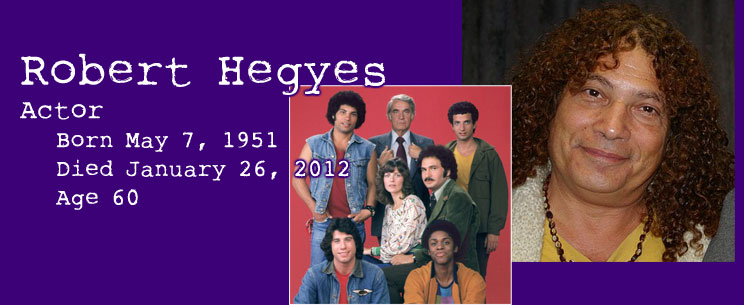 |
||||||||||||||
Robert Hegyes was an Hungarian-Italian-American actor who played Juan Luis Pedro Felipo de Huevos Epstein, a Jewish Puerto Rican, in his role of note on Welcome Back, Kotter, and a Mexican-American police detective for another television series, Cagney & Lacey. Epstein (no relation to Louis) is the character he will be remembered for: the Sweathogs gang member who wrote his own "Please excuse my son from class" notes and signed them "Epstein's mother." According to his New York Times obituary, when Hegyes was teaching a class at Venice High School years later in southern California, he refused to accept almost every written absence excuse. The part of Epstein was not, however, the initial Welcome Back, Kotter role for which he read. He had hoped to play the role of Vinnie Barbarino, the part that eventually went to John Travolta. Like Epstein, Monarc was also voted by his high school senior class "Most Likely to Take a Life." And take a life he has. Hegyes was 60 at the time of his death, so Monarc gets a cool eleven points for the hit and an additional five for being the only one to remember Juan Luis Pedro Felipo de Huevos Epstein in this year's pool. Total: 16. — Bill Schenley's Mother |
||||||||||||||
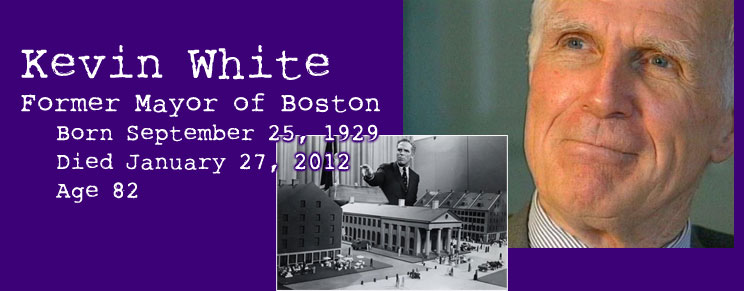 |
||||||||||||||
Gerard Tierney gets the hit, writes the fantastic update, provides a photograph, and generally forgives us for screwing around with his list. Good all around. * * * Funny Kevin White's death should follow so closely on the heels of that of Robert Hegyes. Funnier still that the update for a four-term mayor of Boston would open with an Epstein reference, but the 1970s, a decade that fell somewhere in the middle of White's record tenure, were a crazy time. Or, to use the adjective favored by obituary writers, a turbulent one. On the scale of groundbreaking '70s sitcoms, I would have ranked Welcome Back, Kotter somewere between Hello, Larry and Alice. But in their lengthy obit for Hegyes, the Los Angeles Times — and they would know — insisted the show not only altered the medium but was "plenty controversial" with its "racially diverse cast" and "edgy story line." The Sweathogs, teachers warned, "would glorify, and encourage, student high jinks." And in 1975 Boston, where "there were fears that the show's racially integrated classroom would inflame tensions," the ABC affiliate initially refused to air it. A year earlier, a federal judge had ruled that the city's public schools — over which the mayor had no direct authority — were guilty of racial discrimination, and ordered immediate integration. The busing of black students to previously all-white schools, shall we say, inflamed tensions? For a generation of liberal idealists, a big-city mayor's office was where it was at. Kevin Hagan White campaigned in 1967 as a populist reformer in the mold of New York's John V. Lindsay. And who better to shake up City Hall than a scion of a political dynasty (he was the son and grandson of city council presidents) who'd married into another one? Indeed, his father-in-law, chairing a — surprise! — turbulent 1960 Democratic state convention, had ramrodded through White's nomination for his first of three terms as Secretary of the Commonwealth (that's Secretary of State to you and me). White promised and delivered rent control ("When landlords raise rents, Kevin White raises hell") and, with the backing of the Boston Globe (bucking a seven-decade policy of not endorsing mayoral candidates), defeated an ardent segregationist who'd finished far ahead of him in the primary. Higher office seemed to beckon, but a 1970 bid for governor proved premature. George McGovern reportedly offered him the two-slot on the 1972 ticket but failed to clear it with Ted Kennedy. By 1976, the images of rock throwing and hallway beatings coming out of Boston only served to remind the nation at large of a page in history they thought had already been turned. As the idealism and ambition of the '60s gave way to the realities and narrowing electoral margins of the '70s, White concentrated on building his legacy, not to mention the best damn political machine Boston had seen in a quarter century. Before the decade was out, he'd oversee a construction boom that reshaped the city's skyline, and he'd win an unprecedented fourth consecutive term. Scandal and sagging poll numbers made a fifth term unlikely, though not unthinkable. On May 26, 1983, the Boston Herald, in a headline of Dewey-Defeats-Truman proportions, declared "White Will Run," based on a false tip from the mayor himself. That very night, White took to the airwaves to make it official: There would be no Last Hurrah. But there would. In 2006, despite a 2001 heart attack and a subsequent Alzheimer's diagnosis, White, looking dapper as ever, was on hand for the dedication of a statue — a ten-foot bronze number depicting him in a purposeful stride, outside Boston's Faneuil Hall. Completing the monument were nine footprints, embedded in concrete, tracing his familiar path between City Hall and the Quincy Market area he was credited with helping to develop into a major tourist draw. In late 2010, someone managed to pry loose and steal seven of the cast-bronze footprints, only recently replaced at a cost of more than $12,000 each. No suspects have been identified, but the evidence points to high jinks. In a final twist, White wasn't even on my original slate of candidates this year. Only after a turbulent exchange of emails with the Deadpool staff, in which a number of my nominees were rejected, did I elect to dust White off for another run. After all, how many points could an 82-year-old in declining health for ten years be worth? Turns out it's five for the hit, another five for the unexpected solo. Total: 10. —Gerard Tierney |
||||||||||||||

